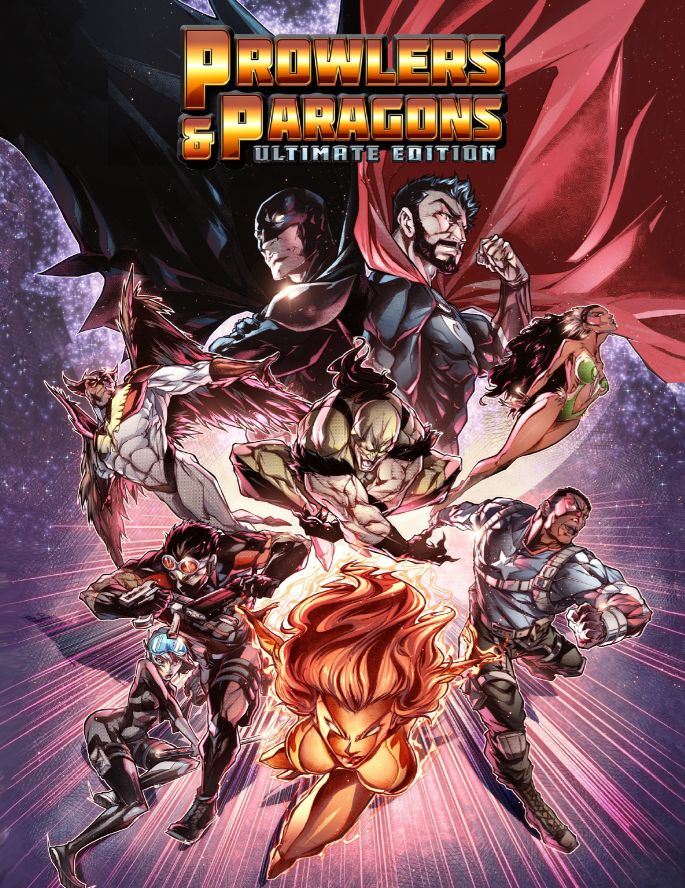Prowlers & Paragons Ultimate Edition
Back in 2016, I released my own superhero game, The Four Color Hack (TFCH). To date, it’s my only product available print-on-demand. It was mostly well-received. Since it’s release, I’ve netted a bit more than $200 from its sales, which for Spes Magna Games is a lot of money. Unfortunately, I sort of ran out of steam for its continued support, which is a shame. I think it’s a pretty good game.
Which brings me to Prowlers & Paragons Ultimate Edition (PPUE) from Evil Beagle Games. PPUE is a new, improved version of Prowlers & Paragons (PP) by Lakeside Games. PP was released about three years before I released TFCH, which is a game I wrote because I wanted to see what a superhero game might look like if it was written specifically for me.
(N.B. The PPUE and PP links are affiliate links. If you click and purchase, I get a few coppers.)
I’ve read in recent days both PPUE and PP. The latter is a good game. The former is a great game. And while neither was written by me specifically for me, they punch a lot of the same jaws that I was aiming for with TFCH. What’s more, PPUE is undoubtedly a better game than TFCH.
Heck, it might very well be the best superhero game on the market today. Seriously. It’s that good.
So, what’s so good about PPUE? Here’s a short but not exhaustive list:
1. PPUE has a unified task resolution mechanic that is easy to grok and is designed to assist the narrative. Everything is rated as X number of dice. You roll the dice, and you count 2s and 4s as one success and 6s as two successes. Subtract the target number from the total number of successes to determine the degree of narrative control the dice roller gets over the action’s results.
2. PPUE respects the genre. Color me pleased that PP and PPUE use comic book terms to describe the flow of action. A page is a round, for example. This sort of terminology found its way into TFCH, proving great minds think alike. The emphasis is on the action, but the comic book melodrama is not ignored. Instead, it’s built right into character creation in the form of Perks and Flaws.
3. PPUE can handle multiple power levels and comic book subgenres. Want to play star-spanning cosmic champions that fight planet-destroying threats? You can do that. Want to play gritty do-gooders who get knocked around in barfights? You can do that too. World War II heroes? Check. Swords and sorcery barbarians fighting evil wizards? Check. Angsty teenagers at an elite prep school for mutants? Yes, that’s possible as well.
4. PPUE has point-based hero creation, but with an emphasis on basic arithmetic. On the other side of the law, the GM can use the point system to make up villains, but that’s not a requirement. PPUE understands that it is not necessary for the enemies faced by the PCs to be made with the same rules as the PCs. Character creation rules are primarily intended to ensure that the PCs are relatively balanced against each other. The NPCs get to do things the PCs don’t get to do, and whinging that this is unfair is beside the point. (If things were fair, there’d be no need for heroes.)
As mentioned in a previous post, I return to campus this week. The students return some time after, and I hope to get my story game club up and running again. PPUE is a strong contender for the first system that I’ll teach the students who participate.
Also, I’ve made up three characters using PPUE. One of them is a hero suitable for play. The other two are villains. The last link is for a villain made using TFCH, just in case you want to do a little compare-constrat. Each link opens a PDF.
Enjoy!
Baron Samedi, a PPUE Villain.
The Galveston Giant, a PPUE Villain.
The Villain, a PPUE Villain. Duh.
Brutacles, a TFCH Villain.

